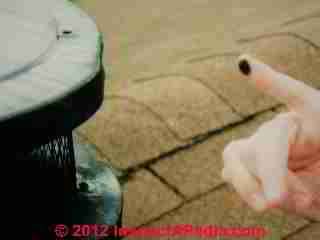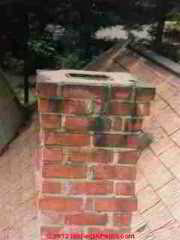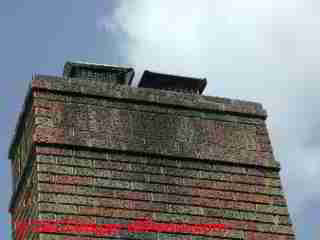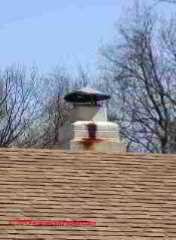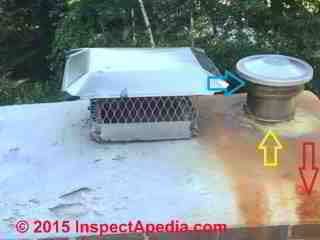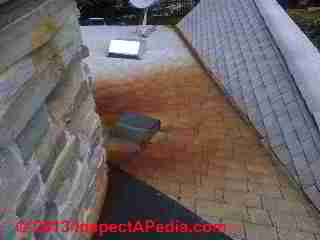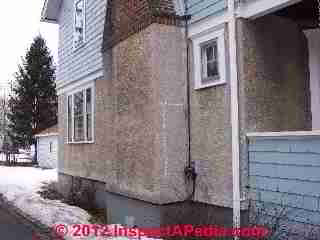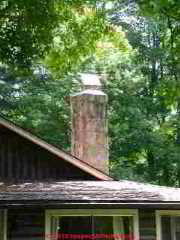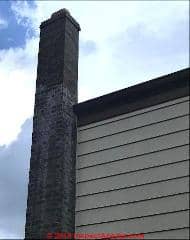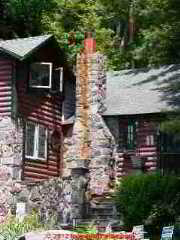 Chimney Stains, Leak, Diagnosis, Cleaning & Repair Guide
Chimney Stains, Leak, Diagnosis, Cleaning & Repair Guide
Diagnose & clean stains on chimney exteriors & building exteriors from chimney defects
- POST a QUESTION or COMMENT about the cause, significance, and cure of stains on chimneys both outside and within buildings
How to diagnose & evaluate stains on chimneys outdoors or indoors & where to look for signs of chimney damage.
This article describes stains that appear on chimney surfaces both indoors and outside. We identify common dark brown or black stains as well as white or light-colored stains or white powdery material that appears on masonry chimney surfaces.
We discuss: What do white powdery stains mean when found on a masonry chimney exterior indoors or outside? How to Evaluate & Diagnose Black or Brown Stains on Chimney Exteriors. Water and Chimney Leaks Lead to Damage that may show up indoors on walls.
Indoor Stains & Wall Damage May Be Traced to Chimney Leaks. Fireplace Stains May Indicate Chimney Leaks & Damage.
Stains and leak damage to a chimney may be visible in the attic. Stains, cracks, evidence of chimney leaks & damage may be visible in the basement.
We explain what these chimney stains might mean, why safety hazards may be present, and how to proceed to inspect and repair the chimney.
InspectAPedia tolerates no conflicts of interest. We have no relationship with advertisers, products, or services discussed at this website.
Significance of Stains on a Chimney Exterior Surface: Creosote, soot, water
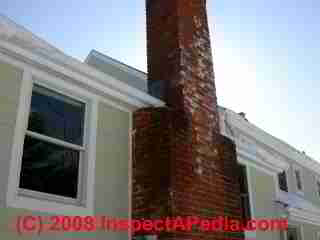 Here we discuss stains found on or at chimneys themselves both on the building exterior, and in the building interior at walls or ceilings near chimneys.
Here we discuss stains found on or at chimneys themselves both on the building exterior, and in the building interior at walls or ceilings near chimneys.
Article Contents
- CHIMNEY STAINS & LEAKS
- BLACK STAINS on CHIMNEYS
- BROWN STAINS on CHIMNEYS
- GREEN STAINS on CHIMNEYS
- RED STAINS on CHIMNEYS
- WHITE STAINS on CHIMNEYS
- LOCATION of STAINS on CHIMNEYS
[Click to enlarge any image]
How to Evaluate & Diagnose Black or Brown Stains on Chimney Exteriors
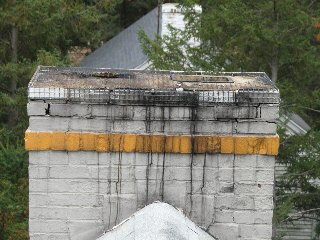 Black Soot Stains on Roof Shingles Around Chimneys
Black Soot Stains on Roof Shingles Around Chimneys
Roof stains due to chimney defects: this section on roof stains at or around chimneys describes how to identify and diagnosis of black roof stains caused by soot or creosote washing off of building chimneys and we discuss possible safety and fire hazards associated with this condition.
Our chimney inspection, cleaning & repair articles discuss all aspects of chimney inspection & troubleshooting, while our building stain diagnosis articles articles tell readers how to identify & explain the most-common causes of black, brown, red, gray, green, or white stains appearing on roof shingles and on other building surfaces.
This article focuses on stains on roofs caused by chimney problems.
Soot from fireplace flues washing down onto the roof - characterized by staining appearing below and in line with the chimney
Similarly, soot from oil-fired heating flues washing down onto the roof, characterized by the same pattern of staining around and below the chimney; also probably an indicator of an operating problem with the heating system.
That was clearly the case in the photograph shown at page top.
At left our photo shows soot stains running down a masonry chimney and onto the roof surface. Incidentally, this chimney needed to be re-lined but evidence of that is not presented in this photo.
Watch out: Gas Flue Safety Warning:
If this same sooting appears on and around a gas-fired appliance flue, there is a very unsafe condition present and risk of fatal carbon monoxide production inside the building. Immediate action is be needed.
[Photograph of a soot-stained roof top at page top was courtesy of Roger Hankey a Minnesota home inspector.
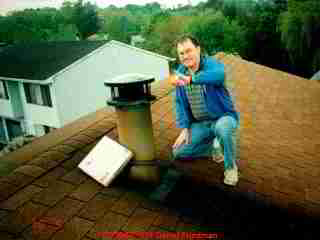 Oil Burner Soot Stains at & Below a Chimney
Oil Burner Soot Stains at & Below a Chimney
In this photo of Roger holding up a sooty pinkie finger on a rooftop suffering impressive black stains, the black stains on the sides of this chimney near its top are probably soot or creosote wash-down.
The chimney flue is short, the chimney cap is thin and cracked, and of course there is no rain cap.
For details
see CHIMNEY CAP & CROWN DEFINITIONS
Look closely for frost damage at both the exterior and interior of this chimney.
Photos of soot at a metal chimney cap and on the roof below were provided courtesy of ASHI inspector Roger Hankey.
Soot at the chimney top (photo at left & below left) , particularly on an oil or gas fired heating equipment flue, is a good indicator of improper equipment adjustment or a related chimney and draft operating problem.
Watch out: sooting gas fired heating equipment is very dangerous and risks production of fatal carbon monoxide gases in the building.
Our second example of a roof stain traced to a chimney is shown in our photo below - rusting metal chimney components.
See ROOF STAINS from CHIMNEYS for details and for more examples of how stains on the roof surface may be caused by problems with chimneys.
Green, Brown & Other Dark Algae Stains on Chimneys
Green stains may appear on masonry, wood, and even (rarely) on metal chimney exteriors in the form of any of several species of algae.
Above we see a chimney with several defects: the flue liner is level with the chimney top surface, lacking a extension so increasing rain or snowmelt waters entering the flue, there is no adequate top crown seal, there is no chimney cap, and the top of the chimney appears to fail to extend 2 ft. above the nearby ridge of the roof.
But excusing those little troubles, notice the green stains on this chimney - that's most-likely algae staining on the brick and mortar surfaces.
Dark Green, Brown, or Black Algae Stains on Masonry Chimneys
The dark stains at the upper center of the brick masonry chimney shown above are probably algae growing in higher concentration on the masonry surface that is most-wetted by runoff from the chimney top.
But we'd want to make an on-roof inspection from much closer to be sure we're not looking at soot deposition.
Red Rust-Colored Stains At & Below Chimneys
Red or rust-colored stains at or around or originating at a metal chimney or chimney rain cap may be caused by rust or by other even more dangerous conditions.
See CHIMNEY CAP & CROWN DEFINITIONS for examples of rust damage at chimney tops, caps, and crowns.
Watch out: See CHIMNEY RAIN CAP OPENING SIZE for an example of a constricted chimney cap, a different and immediately dangerous cause of red and yellow stains at the chimney top shown at above right.
For a detailed analysis of the red roof stains in the photo above,
where we describe tracking red or rust-colored stains on chimneys or roofs to their cause.
Causes of White Stains on Chimney Exteriors: Efflorescence
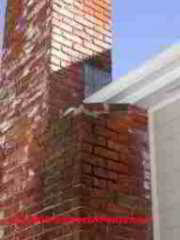 Definition of Efflorescence
Definition of Efflorescence
A white powdery, fluffy, soft, or crystalline stain found on masonry surface is usually efflorescence. Efflorescence is a mineral salt left on the surface as water evaporates.
Efflorescence may appear on the outside surfaces of a chimney both outdoors and inside as well as inside the flue itself.
Efflorescence Colors
While white or light yellowish-white efflorescence is the most common form of this crystalline powdery stain on masonry surfaces, efflorescence may appear in other colors too, even brown, green, or bright yellow. The color of the efflorescence
(You are not likely to see these stains on a metal chimney unless the metal chimney and flue are damaged and leaking insulation material.)
If you are not sure what efflorescence is or how to recognize it,
see EFFLORESCENCE SALTS & WHITE DEPOSITS.
Important to Diagnose the Cause & Effect of Efflorescence on Chimneys
Efflorescence on a chimney might be just cosmetic - as wind-blown rain wets the chimney sides and leaches out mineral salts which remain white on the masonry surface of the chimney.
Watch out: But efflorescence might also mean that water is running inside of the chimney flue or chimney structure. Further diagnostic inspection is needed.
Left unattended, water entering a masonry chimney risks damage to the flue (unsafe) and to the chimney structure (unsound and unsafe).
This chimney is suffering water damage from at least two locations. The white efflorescence along the upper side of the chimney (at left) may originate at a bad chimney cap or rain cap.
But the chimney also seems to be suffering from roof runoff/spillage, perhaps due to a clogged roof gutter - as you can infer from the additional brown and black stains on the right side of this chimney from below the roof eaves.
Inside the building it is important to inspect building walls for signs of chimney leakage and it may be appropriate to have a professional inspect the safety and condition of the entire chimney flue.
To remove these white efflorescence stains on the brick chimney
see EFFLORESCENCE REMOVAL & PREVENTION
In the photograph below, notice the black stains originating at the chimney shoulder on its left side, and the cracking stucco on the chimney's right side in this photograph.
If your chimney inspection began at ground level, both of these clues should raise a red flag and call for close attention to the chimney condition from both outdoors and inside the building.This poor chimney, discussed in more detail
at CHIMNEY MOVEMENT, ONGOING vs STATIC,
was leaning well away from the building - not so easy to notice when inspecting the chimney base shown at left.
In our chimney photo below, notice the black and brown stains (and that odd rain cap) at the upper section of this masonry block chimney.
Now without looking more closely we're not sure if we are seeing a history of creosote wash-down the chimney sides from a woodstove or other heater (the flue is too small for a fireplace), or alternatively, we might discover that the chimney interior flue is damaged, cracked, leaky, sending rain-washed creosote or condensate out thorough the chimney at cracks and mortar joints.
This chimney needs expert inspection for safety and condition.
Other Cause of White Efflorescence or Stains On Chimneys or on the Roof Surface Below a Chimney
At SLATE ROOF DEFECTS Questions & Answers we provide additional discussion about sources of white stains that may be found on chimneys or on roofs below or near chimneys.
Question: trouble removing white stains from chimney - due to "gas leaks" not "efflorescence"
Furnace chimney stained from exhaust gases leeching through flue liner seams and through brick. It is not efllourescence...a quality efflorescence cleaner made it worse when applied...Any info would be very helpful! - 2018/05/31
This Q&A were posted originally at STAINS on BRICK SURFACES
[Click to enlarge any image]
Reply: first make the chimney safe, then choose an effective cleaner
Frank:
IMO in order of importance
- Watch out: The chimney may be unsafe and thus a fire and carbon monoxide hazard to the building, particularly if any of the chimney surfaces are in contact with our built into the structure - its wall(s). The risk is a fire, spark, or flue gas leaking into the building.
In addition, if gas combustion itself is producing ANY soot, black or white, the heating equipment is very unsafe and should be shut down until it has been diagnosed and repaired.
No gas appliance should ever produce black or white soot deposits. Those indicate improper combustion, increasing the risk of a fatal carbon monoxide poisoning.
The experts, the CSIA, Chimney Safety Institute of America, point out that
White stains (efflorescence) on the outside of the masonry chimney ... could point to a venting system problem. ... Eventually corrosion caused by this acidic water condensing inside the flue may cause the liner, mortar, and brickwork to flake and crumble. Chimney sweeps often find this debris creating blockages in the flue, potentially exposing the occupants of the home to carbon monoxide and other dangerous combustion byproducts, a situation not to be taken lightly. - retrieved 2018/05/31, original source: www.csia.org/gas_fireplace.html
The right procedure is to first make the chimney safe, before working to remove ugly stains on its exterior. That means a chimney flue and chimney exterior inspection followed by the necessary repairs.
For your chimney from just your note and the photo I suspect the chimney may need to be re-lined and a cap installed - at the very least.
From your photo I can't see the chimney base - it looks unusual - with just a few inches in contact with the structure - leaving me with further questions:
- What fuel exhaust is being vented: LP gas, natural gas, heating oil?
I presume you will confirm that the fuel is natural or LP gas as I don't see brown or black stains I'd associate with burning heating oil or wood.
Natural gas or LP gas would not itself produce a white residue in or on a chimney.
- What are the white stains?
I'm doubtful that whoever told you the stains are a direct cause of exhaust gas "leaching" through flue liner seams is not speaking precisely nor technically correctly.
Who cares about being so picky? Well if we don't understand what's going on we don't understand the risks involved nor what to do about the stains on your chimney.
When LPG or NG are burned in a heating appliance, as flue gases pass up the chimney, particularly a cool masonry chimney such as yours, (tell me the country and city location) condensate forms inside the flue from moisture in the gas exhaust passing up the chimney.
That's because in perfect combustion burning NG or LPG produces CO2 and water vapor.
That water vapor condenses in the flue.
That condensate might indeed leak through chimney cracks and openings. That condensate is typically acidic and as elaborated in the current Wikipedia entry as I'll give below, so the condensate will not, in the real world, be just pure water.
Efflorescence is a general term for mineral deposits that form on masonry as water passes through the masonry and evaporates from its dry side, leaving an accumulation of salts or other chemicals that were either in the original condensate (or other water source) or chemicals that were dissolved out of the masonry (yours looks like brick, probably with a hard-fired clay flue tile liner and probably including concrete both as mortar between the brick courses and mortar, perhaps imperfectly installed, between the clay flue tile liner sections).
Your chimney has not cap and no visible top seal though I can't see the chimney crown, and I'm not even sure from the photo of all of the chimney construction details and materials.
If a chimney leak were just from rainwater blowing in at the chimney top or down its sides, the chemistry of the white efflorescence that would be produced would be principally determined by what the relatively soft (thus aggressive) rainwater could dissolve from the flue liner clay (not much as that's hard-fired), the concrete used in building the chimney, and the bricks themselves.
The "quality efflorescence cleaner" you tried was probably formulated with that chemistry in mind. It may not have had the necessary solvents to remove acidic deposits of the other chemicals in the condensate nor what those may have dissolved from the mortar, cement, and brick.
The chemistry of the water leaks in your chimney, if we accept your conclusion that the stains are from "exhaust gases leaching through the flue liner" would be more complicated. Keep in mind that exhaust gases don't leach through clay nor brick in any significant way at all.
That's because from your report, it's not rainwater: what's "leaching" would be condensate produced as water in the exhaust gas condenses inside the cool chimney flue as gases pass upwards from the heating appliance.
From the details of other contaminants in NG or LPG condensate you'll see that there is a virtual soup of organics and other substances.
Watch out: The CSIA also points out that
There are some chimney liners that are not compatible with gas appliances because of the material from which they are made. It is important to make sure that the lining system you purchase – or even the one that may currently be in your chimney – is appropriate for use with gas appliances. - op. cit.
Probably your chimney's clay liner is ok but that's another question to discuss with the certified chimney sweep.
Also see Brewer, Jim & Ashley Eldridge,
HOMEOWNERS'S GUIDE to CHIMNEYS, FIREPLACES, and WOODSTOVES [PDF], CSIA, Chimney Safety Institute of America, retrieved 2018/05/31, original source: http://www.csia.org/uploads/9/0/7/3/90732795/homeownersguide3rdedition.pdf
In that document beginning on p. 56 the CSIA offers more advice on chimney stains.
Bottom line: so where are we?
I would talk with the chimney sweep as well as the manufacturer of a couple of other chimney stain removing products to discuss what we speculate is in your chimney's stains to see what they suggest. I'm sorry but I am not smart enough to have a sure-fire answer from just your note.
To remove white efflorescence stains on the brick chimney
see EFFLORESCENCE REMOVAL & PREVENTION
What are the Components of natural gas NG or propane LPG condensate before it has leached through the chimney?
In general, gas condensate has a specific gravity ranging from 0.5 to 0.8, and is composed of hydrocarbons such as propane, butane, pentane, hexane, etc.
Natural gas compounds with more carbon atoms (e.g. pentane, or blends of butane, pentane and other hydrocarbons with additional carbon atoms) exist as liquids at ambient temperatures.[4] Additionally, condensate may contain additional impurities such as:[5][6][7]
- Hydrogen sulfide (H2S)
- Thiols traditionally also called mercaptans (denoted as RSH, where R is an organic group such as methyl, ethyl, etc.)
- Carbon dioxide (CO2)
- Straight-chain alkanes having from 2 to 12 carbon atoms (denoted as C2 to C12)
- Cyclohexane and perhaps other naphthenes
- Aromatics (benzene, toluene, xylenes, and ethylbenzene) - retrieved 2018/05/31, original source: https://en.wikipedia.org/wiki/Natural-gas_condensate
The Location of Roof Stains Can Help Diagnose Their Cause
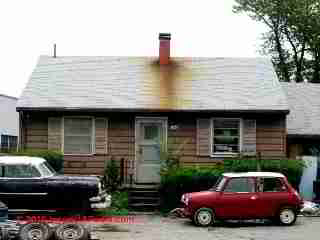 Unlike other roof shingle stain patterns shown in our article series on roof stain diagnosis, black stains caused by soot staining from a chimney
or brown stains from a rusting chimney or chimney flashing, or sometimes a combination of the two will be prominent in a wide swath along the sides and below the chimney and will be little in evidence elsewhere on the roof.
Unlike other roof shingle stain patterns shown in our article series on roof stain diagnosis, black stains caused by soot staining from a chimney
or brown stains from a rusting chimney or chimney flashing, or sometimes a combination of the two will be prominent in a wide swath along the sides and below the chimney and will be little in evidence elsewhere on the roof.
Our photo of red-brown roof stains below and around a metal-enclosed chimney (left) was taken in Wappingers Falls, NY. The stains on this roof are around and below a metal enclosure that in turn surrounds a metal chimney.
This CLOSER LOOK at the CHIMNEY TOP [Image] shows black sooting - the heating system in this home has not been operating properly, and we pose that the roof and chimney stains are probably a combination of rust and soot wash-down from the sooty flue gases as well.
Watch out: we often see that the top of metal box frames around older metal chimneys has rusted through, but may not be noticeable from the ground.
Sending water down the chimney risks costly damage to the heating furnace or boiler. Look for water leak stains on the flue and chimney base inside the building and inspect the chimney top carefully from outside.
...
Continue reading at CHIMNEY STAINS, INDOORS or select a topic from the closely-related articles below, or see the complete ARTICLE INDEX.
Or see CHIMNEY STAINS & LEAKS FAQs - questions & answers posted originally at this page
Reccommended Articles
- CATALOG of ALL ROOF STAINS for the causes and types of stains that occur on building roofs.
- CAUSES of ROOF STAINS
- CHIMNEY CAP & CROWN DEFINITIONS the difference between a chimney rain cap and a chimney top seal - two different possible leak problems.
- CHIMNEY CHASE CONSTRUCTION
- CHIMNEY CLEANOUT DOOR
- CHIMNEY RAIN CAP / RAIN COVER INSPECTION
- CHIMNEY SHOULDER LEAKS
- CHIMNEY STAINS, INDOORS
- CHIMNEY STAINS & LEAKS
- CHIMNEY WET TIME & CORROSION - effects of moisture on metal chimneys & flues
- CRACKED CHIMNEYS, MASONRY BLOCK
- CREOSOTE FIRE HAZARDS
- CREOSOTE HAZARDS
- CREOSOTE ODOR CURE / REMOVAL
- DRIPPING WATER SOUND SOURCES
- EFFLORESCENCE REMOVAL & PREVENTION
- EFFLORESCENCE: WHITE DEPOSITS on ROOFS
- FLASHING, CHIMNEY MISTAKES & LEAKS
- MASONRY CLEANERS
- RUST STAINS on ROOFS Rust and red stains on roofs and chimneys
- STAINS on BRICK SURFACES
- STONE CHIMNEYS, FLASHING, LEAK REPAIR
Suggested citation for this web page
CHIMNEY STAINS & LEAKS at InspectApedia.com - online encyclopedia of building & environmental inspection, testing, diagnosis, repair, & problem prevention advice.
Or see this
INDEX to RELATED ARTICLES: ARTICLE INDEX to CHIMNEYS & FLUES
Or use the SEARCH BOX found below to Ask a Question or Search InspectApedia
Ask a Question or Search InspectApedia
Try the search box just below, or if you prefer, post a question or comment in the Comments box below and we will respond promptly.
Search the InspectApedia website
Note: appearance of your Comment below may be delayed: if your comment contains an image, photograph, web link, or text that looks to the software as if it might be a web link, your posting will appear after it has been approved by a moderator. Apologies for the delay.
Only one image can be added per comment but you can post as many comments, and therefore images, as you like.
You will not receive a notification when a response to your question has been posted.
Please bookmark this page to make it easy for you to check back for our response.
Our Comment Box is provided by Countable Web Productions countable.ca
Citations & References
In addition to any citations in the article above, a full list is available on request.
- Arlene Puentes [Website: www.octoberhome.com ] , an ASHI member and a licensed home inspector in Kingston, NY, and has served on ASHI national committees as well as HVASHI Chapter President. Ms. Puentes can be contacted at ap@octoberhome.com
- In addition to citations & references found in this article, see the research citations given at the end of the related articles found at our suggested
CONTINUE READING or RECOMMENDED ARTICLES.
- Carson, Dunlop & Associates Ltd., 120 Carlton Street Suite 407, Toronto ON M5A 4K2. Tel: (416) 964-9415 1-800-268-7070 Email: info@carsondunlop.com. Alan Carson is a past president of ASHI, the American Society of Home Inspectors.
Thanks to Alan Carson and Bob Dunlop, for permission for InspectAPedia to use text excerpts from The HOME REFERENCE BOOK - the Encyclopedia of Homes and to use illustrations from The ILLUSTRATED HOME .
Carson Dunlop Associates provides extensive home inspection education and report writing material. In gratitude we provide links to tsome Carson Dunlop Associates products and services.


